Browse using the new Vinous website now. Launch →
Printed by, and for the sole use of . All rights reserved © 2015 Vinous Media
Abruzzo: Trials and Tribulations
BY ERIC GUIDO | SEPTEMBER 26, 2024
Abruzzo winemakers have faced myriad challenges in recent years without ever giving up. Notwithstanding the near loss of entire vintages, they are determined to overcome all the curve balls Mother Nature throws at them. These are resilient producers who, in the end, will outwit the climate changes by rethinking vineyard management, winemaking processes and even their choice of varieties.
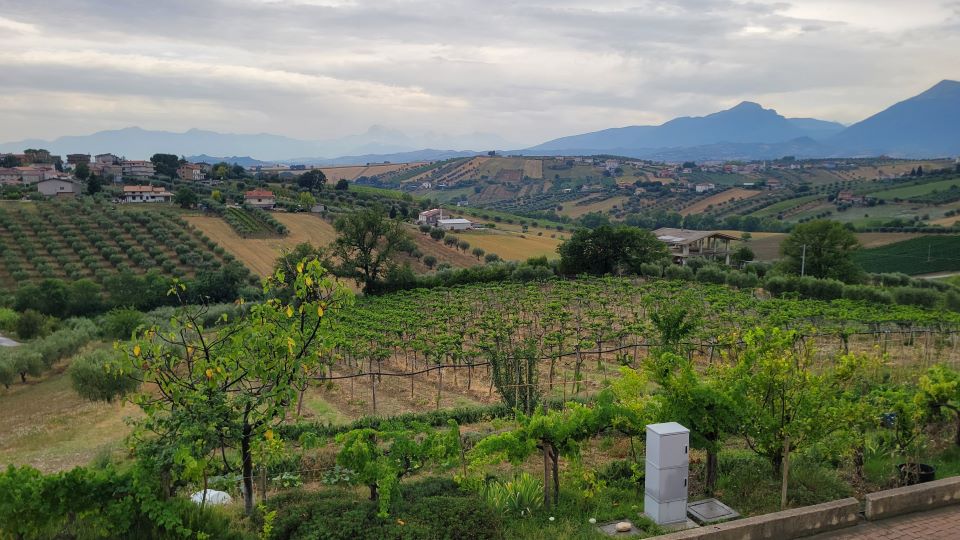
The Case Pepe vineyard in Teramo during the drought of 2024.
Going back over two decades, Abruzzo’s claim to fame was value. Consumers realized that for a $15-$20 bottle of red wine, they could look no further than Montepulciano d’Abruzzo. This same value still exists today. With Trebbiano d’Abruzzo and Pecorino, readers can easily find Montepulciano that over-delivers, by the glass in restaurants. These wines fill a niche that few other regions in Italy can match. In comparison, today’s Chianti Classico prices have escalated much faster.
While this perception remains, what has changed is Abruzzo's place in the hierarchy of fine wines from Italy. At a conference a few months ago, I was asked what the next up-and-coming region is from the boot. Without hesitation, I responded, Abruzzo. There is a serious uptick in quality across the board, and many winemakers are pushing the envelope much further than ever before. There was a time when Valentini and Emidio Pepe were considered the only significant names internationally. Undoubtedly, they were the only wineries that could command higher prices and consistently display the ability of their wines to mature positively over decades. That has changed quite a bit. Emidio Pepe remains at the apex of the scale, and through the progressive and insightful work of Chiara de Iulis Pepe, the estate may surpass the heights reached in past vintages. Today, Tiberio, Praesidium, de Fermo, La Valentina, Torre dei Beati, Terraviva, Amorotti and Cingilia are also part of that group. Each of them continues to produce wines in the value category, which keeps Abruzzo viable in many markets. They also have bottlings that can command a well-deserved premium. Now is the time to explore both Montepulciano and Trebbiano from Abruzzo. Both varieties communicate a sense of place, are vintage-sensitive and can age remarkably well.
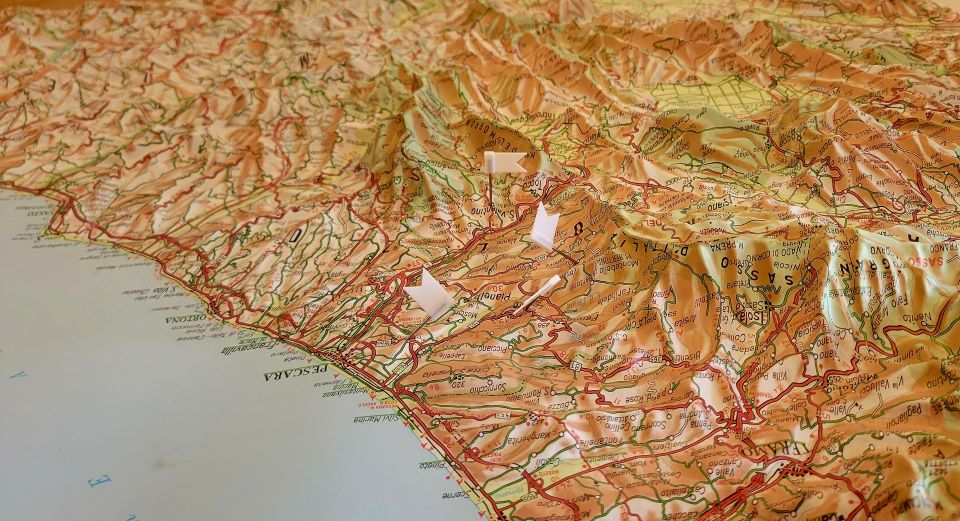
A 3D map depicting the mountainous interior of Abruzzo.
Where and What to Expect
Understanding Abruzzo’s geography is essential. While the territory seems straightforward at first glance, it’s significantly more complex than expected. L'Aquila’s mountainous interior is the largest Abruzzo subregion, running north to south on higher elevations along the Maiella massif and the Apennines' foothills. Due to the rugged terrain, this is the least populated area. Within L'Aquila province, near the border with Pescara, lies the village of Ofena, made known by Cataldi Madonna and considered Abruzzo’s oven. As you move east, the valley opens up to the rolling hills of Pescara, drastically changing the geography and encompassing various climates, from the Maiella massif to the Adriatic Sea. Here, the city's western parts are impacted by cooling air currents descending from the higher ranges to the west. These conditions, combined with the limestone-rich soils offer clear potential. While towns such as Loreto Aprutino and Cugnoli are hotbeds of activity and benefit from the mountains' influence, elevations decline to the east, and the climate becomes more Mediterranean.
From Pescara, moving southwest, the clay-rich flatlands of Chieti are Abruzzo's most significant production zone. While the thirty-two active cooperatives in the area source a large amount of fruit from these vineyards, the province also hosts several well-established properties, such as Masciarelli, Torre Zambra and Tenuta I Fauri. However, from the viewpoint of these wineries, it becomes evident that these are not just flatlands. Here, the region features gently rolling hillsides and thick, lush forests that create a diverse mix of terroir in various locations. One of these areas is the Villamagna DOC (only 85 hectares under vine), established in 2011 by a small group of producers who wanted to differentiate themselves from the broader Chieti region. Under the Villamagna DOC, producers lost the right to use the name Montepulciano on the label, which is unfortunate as many consumers today look for variety before a region or brand.
Finally, in the north, the province of Teramo borders Marche with the Colline Teramane DOCG. For this report, from Colline Teramane, I covered a short list of wineries: Illuminati, Terraviva, Strappelli, Fattoria Nicodemi and Emidio Pepe. The soils here are mainly clay, yet there’s also a good amount of limestone. The terroir is heavily impacted by rolling hills, the Gran Sasso Mountain to the east, and the Adriatic Sea to the west. Colline Teramane enjoys a push and pull of cooling and warming influences. I hope to see more activity in this area as Abruzzo works to improve the definition of its subregions and classifications. There’s a lot of potential here.
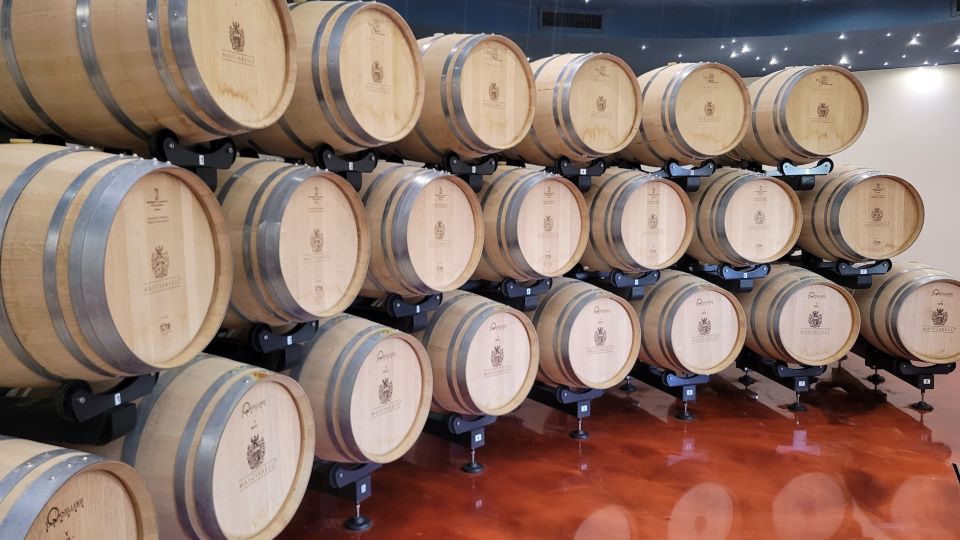
Barrel aging of Trebbiano d'Abruzzo at the Masciarelli winery.
Restructuring the Abruzzo DOC
Readers who want to better understand the significant changes taking place in Abruzzo’s classification system of subregions and place names, along with the introduction of the Superiore and Riserva categories for the Abruzzo DOC, check out last year's article Chomping at the Bit: New Releases from Abruzzo, which goes into meticulous detail. It also explains the removal of the eight existing territorial IGTs, as of the 2023 vintage, in place of the new Terre d’Abruzzo IGT. This change may both benefit and hinder the small, terroir-driven winemakers. As a result of many good intentions, Abruzzo is going through a major restructuring, but there will be growing pains over the coming years. Despite these efforts, of the sixty-nine 2023s submitted for review on my recent trip, only seven mention the Superiore classification. Of those, the majority are Cerasuolo.
That said, some smaller regions within Abruzzo have begun their own research into the individual terroirs, conducting soil studies and geological surveys to understand their own area better and communicate with consumers. This year, the Custodes Laureti (Guardians of Loreto), formed in Loreto Aprutino through the combined efforts of Amorotti, Ciavolich, De Fermo, Talamonti, Torre dei Beati and Valentini, collaborated with Gabriele Valentini, a researcher at the University of Bologna to publish The Wine-Growing Lands of Loreto Aprutino. The book is an in-depth study of the village's history, climate, terrain, vintages and surrounding vineyards. Seeing a work like this come into creation gives me hope for the entire region.
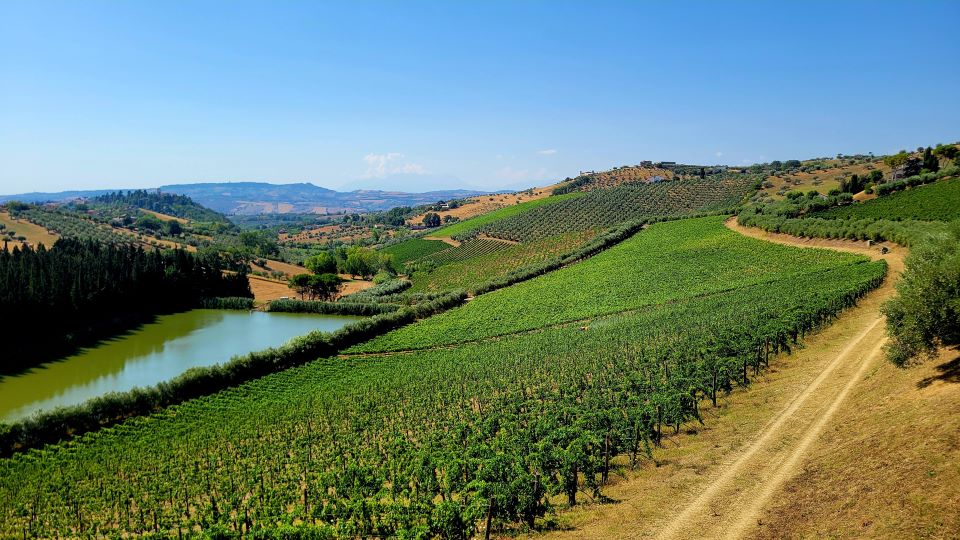
The vineyards of Nicodemi in the subregion of Teramo.
Challenges of Recent Vintages
Despite considerable efforts, Abruzzo has undergone a series of challenging vintages in recent years that have been marked by extreme weather events. A warmer climate results in rising alcohol levels and, in some cases, a shift in style for certain wines. However, these trends haven’t drastically hurt Abruzzo compared to other wine-growing areas. Even though the Montepulciano grape from Abruzzo grows darker and richer today, it still finds a healthy balance following a severely hot summer due to its late-ripening nature and the clay-rich soils that retain water. Especially as the snow slowly melts and runs down the surrounding mountains. However, winemakers remain vulnerable to unpredictable weather patterns, including heavy rainfalls, prolonged droughts, hail and late-season frosts, testing their resilience.
Like most of Italy, in 2023, Abruzzo received unrelenting rain throughout the spring and into the early summer. This situation created a widespread outbreak of peronospora, otherwise known as downy mildew. This was a death sentence in a region like Abruzzo, where the majority of producers are certified organic. The combination of muddy soils, which prevented the use of tractors, and organic treatments that would wash off the vines as quickly as they were applied gave winemakers little defense against the outbreak.
While touring the region in July 2023, the word was that Chieti had lost 70-80% of their production. Their location close to the sea, with its warming influences, created a breeding ground for peronospora. Even the plants that survived the attack remained at risk of being further affected by mold that infected the bunches. When all was said and done, many wineries, specifically near the coast, decided against bottling any of their wines or using what little fruit they had to declassify into a single bottling, such as a Cerasuolo. Luckily for the region as a whole, the inland areas of Abruzzo were less impacted. In the western parts of Pescara or L'Aquila, the ventilating winds and cooler temperatures helped ward off disease to a degree. However, they also suffered through a killing frost in April that reduced production. In the end, no one was left unscathed. In general, the Montepulciano grape was hurt the most in 2023. Expect drastically reduced production if any wine is bottled at all. As for the whites, many have achieved a lovely balance, showing more minerality and elevated acidity. The portfolio of whites from Cingilia and Tiberio in Cugnoli shows how well Trebbiano and Pecorino fared in 2023, further away from the coast.
As if this wasn’t enough, the 2024 vintage, to date, flipped the script once again. While the season is still ongoing at the time of writing, 2024 reversed the situation of 2023 from both a climatic and location standpoint. The issue is primarily a combination of heat and drought. From spring to August, Abruzzo suffered through arid conditions. While the region received a good amount of rain in just the last few weeks, it was just 50% of the average rainfall from a regular season. In this case, locations closer to the coast fared much better, receiving a small amount of periodic precipitation, while inland producers are in a dire situation, with minuscule canopies and tiny bunches.
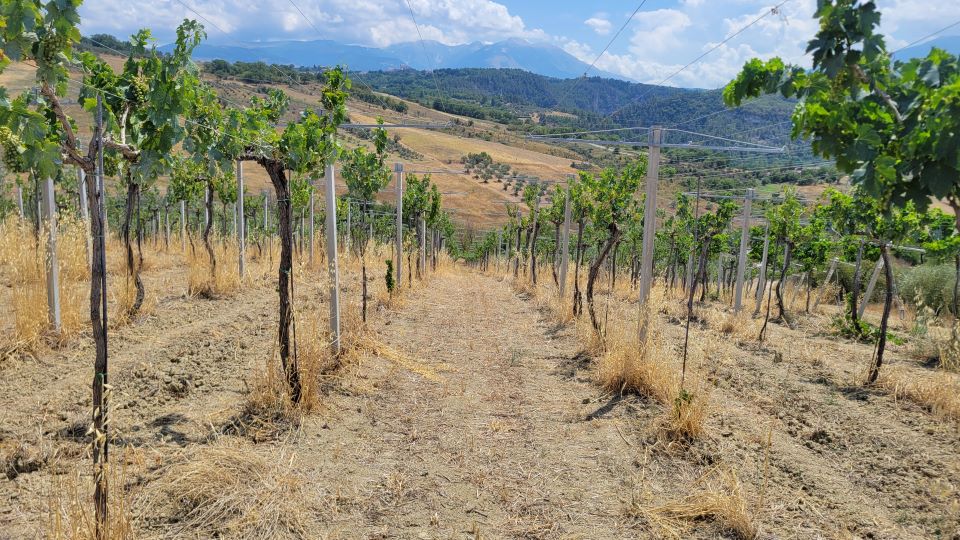
La Valentina's vineyards during the drought of 2024.
This is starting to become a trend. Stefano Papetti Ceroni of De Fermo explained, “The last real snow I’ve seen here was five years ago; it lasted for a day, and then it was gone.” In a region without irrigation, snow is very important. Even in the dry season, snow that slowly melts from the tops of the mountains works its way down to the lower elevations and helps to replenish moisture in their soils. Some winemakers question how long Montepulciano can remain their primary grape variety. Valentini hasn’t produced one since 2015, feeling that the color and fruit profile changed too drastically. Fabio Di Donato of Cingilia decided against bottling Montepulciano in 2022, then lost it to peronospora in 2023, and as of my interview with him in July of 2024, he will not bottle again so that the plants could rest through the difficult season. Cristiana Tiberio also plans not to harvest her old vine Montepulciano, noting, “Even if it does begin to rain, there’s no way to recover from this.” She went on to detail how the lack of rain wasn’t the real culprit of the damage done. Tiberio explained that a cold air mass moved through the region in late April, causing the vines to shut down. When all is said and done, there will be wine in 2024; the question is how much and what kind of character the fruit will bear.
As for most wines entering the market, the following notes primarily cover the 2022 and 2023 vintages, late-release 2021s and some 2020 Riservas. From this mix of vintages, 2021 and 2022 were excessively warm years, yet each has its silver lining and found balance through different means. While 2020 and 2021 were covered in detail previously, it’s the 2022 reds that are generally entering the market, and I must say that I find them immensely charming. The 2022s are elegant and seductive, with a nice balance of acidity to maintain a juicy personality. While warmer than average, the 2022 vintage benefitted from springtime precipitation that helped to build up water reserves in the soils, which resulted in early yet healthy flowering. The year's dry conditions didn’t settle in until summer, accompanied by hot temperatures that forced vines to shut down through parts of July and August. Rain in September helped to provide balance, along with cooler temperatures that lasted through an anticipated harvest, on average, a week early. Many producers reported that they had very healthy grapes. Some struggled with Montepulciano, while nearly all agreed that the whites suffered less. Ultimately, the big challenge was achieving phenolic maturation without excessively high alcohols.
I tasted the wines for this article while in Abruzzo in July of 2024.
© 2024, Vinous. No portion of this article may be copied, shared or re-distributed without prior consent from Vinous. Doing so is not only a violation of our copyright, but also threatens the survival of independent wine criticism.
You Might Also Enjoy
Tiberio's Fonte Canale: Redefining Trebbiano d'Abruzzo, Eric Guido, August 2024
Chomping at the Bit: New Releases from Abruzzo, Eric Guido, August 2023
Abruzzo: The Great Divide, Eric Guido, October 2022
Abruzzo and Molise: More Than Meets the Eye, Eric Guido, April 2021
Show all the wines (sorted by score)
- Amorotti
- Arche'
- Barone Cornacchia
- Binomio
- Cantina Tollo
- Cantina Zaccagnini
- Castorani
- Cataldi Madonna
- Chiarieri
- Ciavolich
- Cingilia
- De Fermo
- Emidio Pepe
- Fantini
- Fattoria Nicodemi
- Feudo Antico
- Fiamme
- Fontefico
- Fosso Corno
- Francesco Cirelli
- Idi di Marzo
- Il Feuduccio
- Illuminati
- Jasci & Marchesani
- La Valentina
- Marchesi de Cordano
- Masciarelli
- Masciarelli - Marina Cvetic
- Masciarelli - Villa Gemma
- Mastrangelo
- Nic Tartaglia
- Pasetti
- Praesidium
- San Lorenzo - Castilenti
- Solnato
- Strappelli
- Talamonti
- Tenuta Cerulli Spinozzi
- Tenuta I Fauri
- Terrasublata
- Terraviva
- The Last Grapes
- Tiberio
- Torre dei Beati
- Torre Raone
- Torre Zambra
- Valentini
- Valle Martello
- Valle Reale
- Valori - Masciarelli
- Velenosi
- Visconti della Rocca
